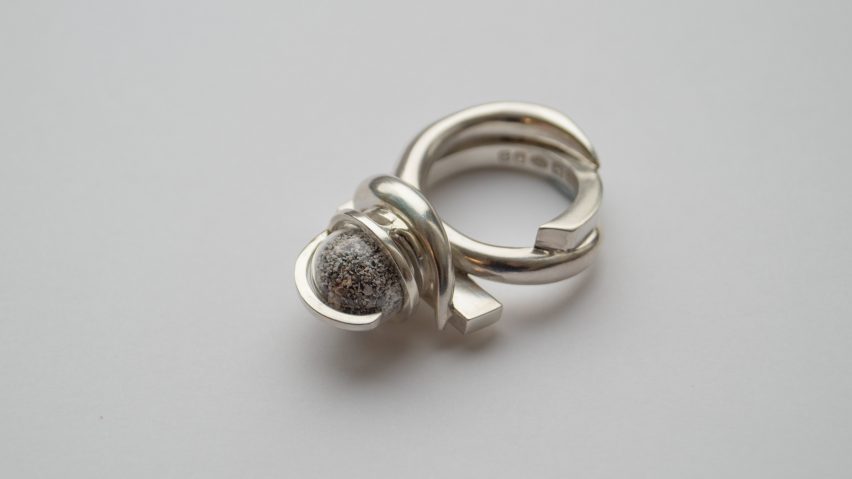Metals "mined" by plants feature in a first-of-its-kind ring, made by materials researcher and designer Karoline Healy under her jewellery brand H2ERǴ.
The metals were obtained using the emerging technology of phytomining, in which special species of plants known as hyperaccumulators suck up metals from the soil through their roots.
The technology is so nascent that Healy's is the first known jewellery item, if not the first object, to be made using materials obtained through the process – even if they are only contained in the decorative sphere set into the ring and not the band itself.
Healy became interested in phytomining and other types of biomining while working on a material research project for a consumer electronics company that wanted to source more sustainable steel for their products.
Here, she came across the work of biogeochemist Antony Van Der Ent in New Scientist magazine, who discovered nickel hyperaccumulator plants in the Borneo jungle.
"These plants look extraordinary," Healy told Dezeen. "They bleed green nickel sap – nickel being a necessary element for stainless steel alloys."
After that, she said, she learnt of other useful interactions between biological organisms and metals, such as a bacteria that can "eat gold" from waste circuit boards and a fungus in Australia that gathers gold particles on its body.
This led her to start her ongoing research project, Future Metals, of which the ring is a part.
"As a jeweller I connected the dots and thought about how it would be possible to source precious metals using biology in a renewable way, being in harmony with ecosystems, acting as a reason to clean up waste," she said.
Healy's work was made possible through a collaboration with the UK-based biomining start-up Phyona, whose mining sites constitute gardens planted in areas of polluted soil.
The metals for the H2ERǴ ring came from the Miners Garden at the Barnsley Main Colliery, a heritage coal mining site in the north of England that closed in 1991.
The plants help to remove contaminants from the soil – a process known as bioremediation – while also providing a potential cache of usable metals, if the recovery techniques can be perfected.
That is where most current research in the field is focused, along with identifying and optimising hyperaccumulator plant species.
Most commonly, the plants are burnt and the metals are extracted chemically from the ash. But Phyona's goal is to develop a more ecological and low-carbon processing method, and it tested a number of possibilities while extracting the metals in Healy's ring.
This included the ashing method, as well as organic and green chemistry approaches, where hazardous substances are avoided. The company is now using a fully bio-based method.
The plants in the New Miners Garden are native foxgloves, thistles and grasses that can gather metals including silver, nickel, copper and zinc.
All of these feature within Healy's ring as a mixed metallic dust contained within a transparent sphere.
The reason for this presentation is twofold. First, the processing techniques to further extract, isolate and purify the metals are still in development. And second, she likes it as a symbolic link to the ring's origins in the Miners Garden.
"Phyona planted a range of native hyperaccumulator plants together, each plant being accustomed to sucking up a specific type of metal or mineral," said Healy. "This helps to clean the Barnsley Main site as there is a mix of metal contamination present in the soil."
"In locations where there might be a more specific type of metal contamination, it could be more straightforward to harvest one type of metal straight from a specific plant."
While Healy thinks it's unlikely that phytomining will ever compete with today's mining operations on scale, she does think it could at least be a partial substitute, particularly if metal reserves become depleted as some experts predict.
"Ores and feedstocks that are deemed uneconomical to process with today's methods will soon need to be revisited," she said. "And this is where I think phytomining and other types of bio-mining to extract metals will be paramount."
Healy's ring is currently on display at a museum on the Barnsley Main Colliery site.
The natural processes of plants and other organisms are increasingly a point of interest for designers engaged in the field of biodesign, which has recently seen the emergence of clothing dyed with bacterial pigments, fabric made from fermentation and furniture made in collaboration with mealworms.

